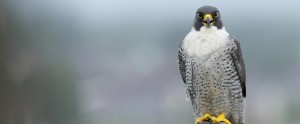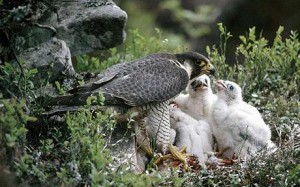Week 32 – 19 February 2017:
Small Parasites with Big Consequences
In the previous entry, I described Peregrine Falcons as big, bold and beautiful. Peregrines have been hunted in Europe in the past. The release of hydrocarbons into the environment in decades gone caused eggshell thinning and mortality for both embryos and adults. Despite this, the world population of these wonderful birds now appears to be safe. Even the capture of wild Peregrines on the Arabian Peninsula for use in falconry is having no noticeable influence on their abundance. That is not to say that the life of a Peregrine Falcon is always easy.
Rankin Inlet, a hamlet on the northwestern shore of Hudson Bay in Nunavut, Canada, has about 2500 residents. The region is also home to a dense breeding population of Peregrine Falcons which have been studied intensively since 1982. Starting in 2007, Peregrine nesting sites in the area have been monitored using motion-sensitive cameras. In most seasons, cameras capture the comings and goings of Peregrine parents and their chicks; incubating, brooding, begging, feeding, and so on. The 2013 breeding season was different, as reported by Alastair Franke, principal investigator at the Arctic Raptors Project, and his colleagues.
A pair of Peregrine were in attendance at a monitored nest of four eggs, two of which hatched on 12 July, and the other two a day later. Franke and his team visited the nest on 19 July, and the chicks appeared to be developing normally. When the nest was visited again seven days later, the chicks were gone, and the parents were not in attendance. The nestlings were far too young to have fledged. What had happened?
Images from the cameras revealed the gruesome story. On 20 July, the chicks were being fed and brooded in typical fashion. Footage from 17:15 showed that blood-feeding black flies had descended on the chicks. Within two-and-a-half hours, bleeding lesions could be seen. By 21:00, “all four nestlings displayed widespread, uniformly distributed hemorrhagic lesions over the body and multiple coalescent head lesions.” An hour later, the camera switched to infrared mode, and continued to document events at the nest. Over a thirty minutes period starting at 03:30 the female removed the bodies of all four chicks, now dead, from the nest.
Cameras at other nest sites also showed black fly attacks in 2013. Of ten nests monitored, thirteen of thirty-five chicks died. A less serious outbreak of blood-feeding flies had occurred in 2012, resulting in the death of seven nestlings. In no other year was any Peregrine chick mortality linked to black flies.
Could the deaths of young Peregrines as a result of biting flies be linked to global climate change? Average summer temperatures in the study area have risen by about 1.5 degrees C over the past three decades. Heavy rainfall events have also become more frequent. Franke et al. explained that periodic black fly outbreaks may be nothing more than normal but infrequent events resulting from a particular combination of rainfall and temperature. Either way, it seems that blood-feeding black flies are an important component of the breeding biology of birds in the Arctic.
Franke, A., V. Lamarre, and E. Hedlin. 2016. Rapid nestling mortality in Arctic Peregrine Falcons due to the biting effects of black flies. Artic 69:281-285.
Photo credits: Peregrine Falcon perched on a hotel roof in Manchester city centre - www.rspb.org.uk; nest with chicks - elasharespace2015.wikispaces.com



